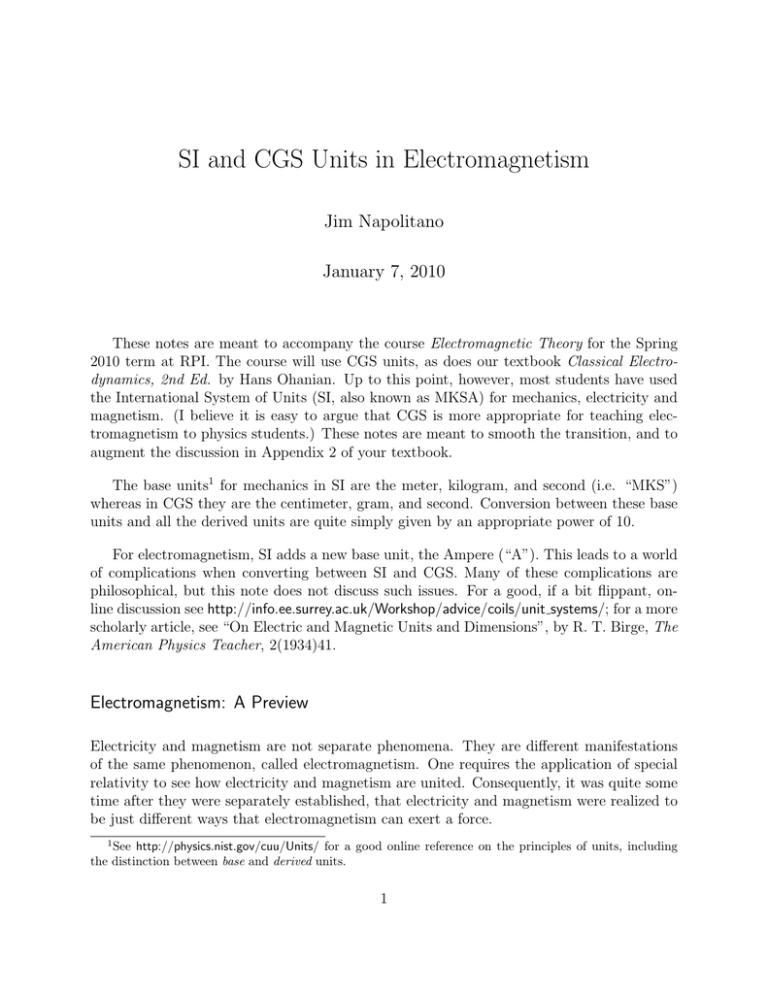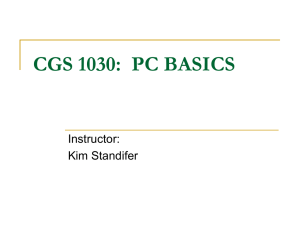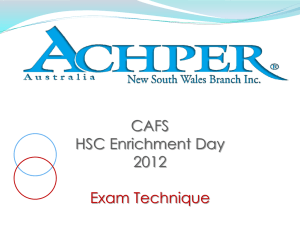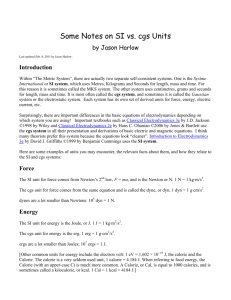SI and CGS Units in Electromagnetism
advertisement

SI and CGS Units in Electromagnetism Jim Napolitano January 7, 2010 These notes are meant to accompany the course Electromagnetic Theory for the Spring 2010 term at RPI. The course will use CGS units, as does our textbook Classical Electrodynamics, 2nd Ed. by Hans Ohanian. Up to this point, however, most students have used the International System of Units (SI, also known as MKSA) for mechanics, electricity and magnetism. (I believe it is easy to argue that CGS is more appropriate for teaching electromagnetism to physics students.) These notes are meant to smooth the transition, and to augment the discussion in Appendix 2 of your textbook. The base units1 for mechanics in SI are the meter, kilogram, and second (i.e. “MKS”) whereas in CGS they are the centimeter, gram, and second. Conversion between these base units and all the derived units are quite simply given by an appropriate power of 10. For electromagnetism, SI adds a new base unit, the Ampere (“A”). This leads to a world of complications when converting between SI and CGS. Many of these complications are philosophical, but this note does not discuss such issues. For a good, if a bit flippant, online discussion see http://info.ee.surrey.ac.uk/Workshop/advice/coils/unit systems/; for a more scholarly article, see “On Electric and Magnetic Units and Dimensions”, by R. T. Birge, The American Physics Teacher, 2(1934)41. Electromagnetism: A Preview Electricity and magnetism are not separate phenomena. They are different manifestations of the same phenomenon, called electromagnetism. One requires the application of special relativity to see how electricity and magnetism are united. Consequently, it was quite some time after they were separately established, that electricity and magnetism were realized to be just different ways that electromagnetism can exert a force. 1 See http://physics.nist.gov/cuu/Units/ for a good online reference on the principles of units, including the distinction between base and derived units. 1 The starting place for an “electric” force is Coulomb’s Law. If some number of electrons is added to, or removed from, an object, then it acquires a “charge” q. A force appears between two charged objects separated by some distance. This force is proportional to the product of the charges, and inversely proportional to the square of the distance between them. That is, q1 q2 (1) F = kE 2 d Here kE is an arbitrary constant of proportionality; without describing what we mean by “charge,” we can say no more about it. A “magnetic” force appears between two wires, each of which carries something called a “current.” For two long, parallel wires, the force per unit length is proportional to the product of the currents and inversely proportional to the perpendicular separation of the wires. That is, I1 I2 F = kM (2) L d As with the electric force, kM is a generic constant of proportionality which depends on what we mean by “current.” Today we understand that (1) and (2) are two different manifestations of “electromagnetism.” A “current” is in fact a flow of “charge,” and electromagnetism tells us that 2kE = c2 kM (3) In other words, if we make a choice for kE , then (3) specifies kM and vice versa. Here’s the thing. The SI and CGS systems make different choices for kE or kM . There can be choices, of course, which lead to systems of units other than SI and CGS, but we will not generally be using them in this course. The SI System: Inventing a Unit for Current The SI system is based on (2). People learned how to make current, well before we understood it in terms of charge. Perhaps for these reasons, a new base unit, the ampere (A), was created. One Ampere is the amount of current flowing in each of two long, parallel wires, separated by one meter, such that the force between the wires is 2 × 10−7 N/m. We write kM = where µ0 2π SI µ0 ≡ 4π × 10−7 (4) N A2 (5) (The factor of 4π turns out to be handy to cancel out integrations over the unit sphere.) 2 This quantity µ0 turns out to describe the magnetic properties of the vacuum. It shows up, for example, in the inductance of a loop of wire surrounding empty space. This is all forced upon us by the invention of the Ampere. Some books refer to µ0 as the “permeability of free space.” Equations (3) and (4) tell us how to write Coulomb’s Law (1) in the SI system. We have kE = µ 0 c2 c2 kM = 2 4π SI = 8.99 × 109 N · m2 (A · s)2 (6) (7) The form of Coulomb’s Law shows that charge, in the SI system, has units Amperes×seconds (A · s). This is defined to be the Coulomb (C). SI furthermore defines the quantity 0 ≡ 1 µ 0 c2 (8) called the “permittivity of free space.” It is another property of the vacuum, showing up, for example, as the capacitance of parallel plates separated by empty space. It is, as with µ0 , forced upon us by the choosing a new base unit for current. Thus, combining (1), (6), and (8), we write Coulomb’s Law in SI as F = 1 q1 q2 4π0 d2 SI (9) which is the form presented in introductory physics textbooks that use the SI convention. The CGS System: No New Base Units In CGS we take the point of view that no new base units are necessary. We write kE = 1 CGS (10) that is, a dimensionless number. In other words, Coloumb’s Law (1) is simply F = q1 q 2 d2 CGS (11) The unit of charge in CGS is derived in terms of centimeters, grams, and seconds. It is called the electrostatic unit (esu), or sometimes the statcoulomb, and is simply2 p esu ≡ dyne · cm2 = g1/2 · cm3/2 /s (12) 2 Recall that the unit of force in CGS is called the dyne ≡ g · cm/s2 = 10−5 N. 3 Our course will start with (11) and use the principles and formalism of special relativity to arrive at (2). See Equations 25 and 93 in Chapter 9 of your textbook. The result is of course just (2) with (3), namely 2 I1 I2 F = 2 L c d CGS (13) CGS is not without its sources of confusion. Some authors3 use (13) to define a unit of current, the statampere, which gives 2 dynes/cm of force between two long parallel wires separated by 1 cm. Note that this is not the same as one esu/s, something called the “absolute ampere” or “abampere.” The statampere and abampere differ by a factor of 2.998 × 1010 , although they have the same dimensions, namely those of the esu/s = g1/2 · cm3/2 /s2 . Converting between SI and CGS The units of charge and current have different dimensions between SI and CGS, and this is why everyone encounters confusion when converting between one system and the other. Of course, all of this boils down to experiment. You make a measurement, and use some equations (whether they are CGS or SI) to interpret the result. We’ll take the point of view of Coulomb’s Law as a starting point, and the classic work by Millikan4 to measure the charge on a single electron, a (negative) quantity that we traditionally call −e. The modern best value for his measurement is e = 4.8032042 × 10−10 esu. So let’s start by giving ourselves the problem of expressing the charge on an electron in Coulombs. This is easy. Let eesu equal the dimensionless number 4.8032042 × 10−10 . The force between two electrons separated by one meter is 10−4 e2esu dyne = 10−9 e2esu N. So, in SI 10−9 e2esu N = e2 µ 0 c2 e 2 1 = = 10−7 c2SI e2C N 4π0 (1 m)2 4π (1 m)2 (14) where eC is the electron charge in Coulombs, and cSI ≡ 2.998 × 108 , is yet another dimensionless number. Then eC = eesu /10cSI = 1.602 × 10−19 . This procedure is obviously valid regardless of the charge on an electron. We therefore write qC = qesu /10cSI = qesu /2.998 × 109 (15) as a general conversion between charge in the CGS system to that in SI. That is, one Coulomb represents a much larger amount of charge (i.e. very many more electrons) than one esu, by a factor of 10cSI . 3 Ohanian is not one of them. This experiment was a tour de force, which Millikan carried out systematically and carefully over two decades. For a culmination of this work, see his paper “The Most Probable 1930 Values of the Electron and Related Constants” in Phys. Rev. 35(1930)1231. He determined the value e = (4.770 ± 0.005) × 10−10 esu. 4 4 The trick here was to recognize that the numerical difference between Coulombs and esu is absorbed by the factor c2 in (14). This is not to say that Coulombs and esu differ by the dimensions of velocity. One cannot equate Coulombs to esu without some conversion factor that explicitly cancels out the base unit Amperes. We can extend from here. Consider the units of electric potential, defined by therefore 1 Joule = 1 Volt · C SI 1 erg = 1 statvolt · esu 1 Volt · C = 107 statvolt · esu CGS (16) (17) (18) since one Joule equals 107 ergs. (I like this way of writing things because it means I can use the “=” sign. Energy is energy, whether CGS or SI.) Now thinking again in terms of number of electrons, we know that one Coulomb corresponds to 10cSI times as much charge as an esu. So we write, now having to abandon a strict equality, 1 Volt · 10cSI ⇐⇒ 107 statvolt or 1 statvolt ⇐⇒ 299.8 Volt (19) (20) In other words, in practical terms, one statvolt is the same as 300 volts.5 The same thing works symbolically, of course. To go from CGS to SI we need to insert the factor µ0 c2 /4π = 1/4π0 in front of Coulomb’s law, and rederive things. √ So, wherever we encounter a value of charge q in a CGS equation, we replace it with q/ 4π0 . (The trivial conversions from centimeters and grams to meters and pkilograms are irrelevant symbolically.) Similarly, any values of current I get replaced by cI µ0 /4π. You can easily check that these substitutions turn (11) into (9), and (13) into √ (2) w/(4). For a different example, the electric field E = limq0 →0 F/q0 gets multiplied by 4π0 leaving (of course) the force for a charge in an electric field F = qE unchanged. Now let’s try going the other way, namely SI to CGS, with the Lorentz force law, namely F = qE + qv × B SI (21) We p the first term on the right is unchanged. In the second term, replace q with √ know that q 4π0 = q 4π/µ0 /c, but what about the B field? Our study of electromagnetism will lead us to Ampere’s Law, which relates magnetic fields and currents. Indeed, steady currents give rise to static magnetic fields according to 4π ∇×B = j CGS (22a) c ∇ × B = µ0 j SI (22b) 5 Perhaps here is a reason that SI is more popular with electricians and engineers. We always prefer to use numbers on the order of unity when doing practical work. One volt is a reasonable potential difference from a human perspective, but 300 volts would give you a rather significant shock. So, if we worked in CGS, practical electronics would be discussed in terms of “millistatvolts”, a somewhat unwieldy term. 5 p where j is the current density. To go from CGS to SI, j gets multiplied by cI µ0 /4π, so p equations (22) tell p us to multiply B by p 4π/µ0 . So, getting back to (21) we multiply the second term by 4π/µ0 /c for q and µ0 /4π for B. (Remember, we are going from SI to CGS.) We therefore arrive at the Lorentz force law F = qE + q v ×B c CGS (23) An important lesson in this last example, which we will drive home during our course, is that in going from SI to CGS, the magnetic field changes its dimensions differently than does the electric field. Indeed, (21) shows that in SI, the dimensions of E are the dimensions of B multiplied by the dimensions of velocity. On the other hand, (23) shows that in CGS, E and B have the same dimensions. This actually goes to the heart of one of the reasons I will be teaching this material using CGS units. We could go on from here, but we won’t. Table A.2 (in Appendix 2) of your textbook lists a collection of expressions as they would appear in either CGS or SI. It would be worth your while to derive a few of these to convince yourself that you know what you are doing. Further Reading First, see the Appendices in your textbook. Appendix 1 gives the fundamental constants in both CGS and SI units. Appendix 2 discusses the manner of conversion, and is, for all intents and purposes, a concise version of this note. The standard graduate textbook Classical Electrodynamics by J. D. Jackson has an appendix which thoroughly goes through the various popular systems of units, based on choices for kE or kM . It also includes many tables that you can use for conversion of formulas or constants. Interestingly, the second edition of this book uses CGS units exclusively, while the third edition uses SI for the first part, and switches to CGS for the second. (You’ll have to read the preface to get some idea of how Jackson justifies this craziness.) The paper R. T. Birge, The American Physics Teacher, 2(1934)41, which I mention at the start of this note, is referenced by Jackson. It may well be the first time these things were put down in print, albeit at a time when there were vehement discussions about which ought to be adopted as an international standard. (Of course, SI won.) You can locate online references as well as I can, but here are a couple of pointers. In the introduction, I mention a website which, although flippant, does seem to cover the basics rather thoroughly. I also find the Wikipedia entry useful: http://en.wikipedia.org/wiki/Centimetre gram second system of units 6



